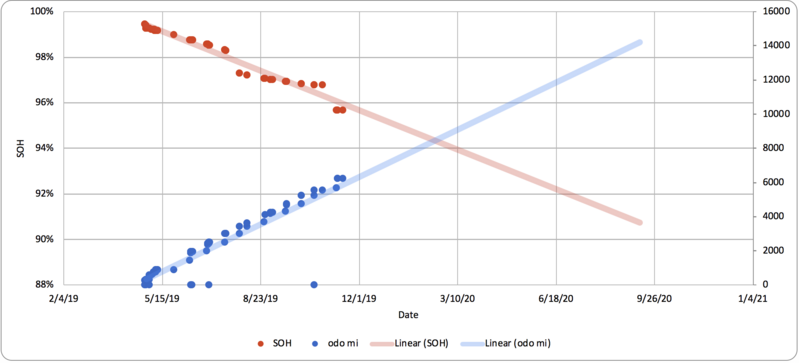Daklein
Well-known member
_The_ place to post battery info, SOH (state of health), Ahr (capacity), temperature observations over time, with info about how the pack is being treated, and other things relating to the new 2019+ 62kWh Plus pack. (Like the The 40kWh Topic): https://www.mynissanleaf.com/viewtopic.php?f=9&t=25773
There are a few stats scattered in other topics, but having this one should make it easier to keep track of them. The one I've seen is the Leaf Plus efficiency thread: https://www.mynissanleaf.com/viewtopic.php?f=31&t=29971 Please add Links if there are other threads with data points on the 62kWh pack. If we find ourselves bored, someone can summarize and plot the data in a google spreadsheet.
My pack came without a car :shock:
:shock:  , but it looks like it's in good shape. It came from a salvage yard near Smyrna TN, likely from a dismantled non-saleable development vehicle, allegedly with 6000 miles on it. We'll see on first discharge if it stays well balanced or not. It could always look fine top balanced but fall apart on discharge if some cells are special. I hope to get it running in the near future, and enjoy living with 62kWh! I'm curious to see if having it sitting at 91% SOC until I get it running (plus who knows how long before I got it) will impact the SOH at all.
, but it looks like it's in good shape. It came from a salvage yard near Smyrna TN, likely from a dismantled non-saleable development vehicle, allegedly with 6000 miles on it. We'll see on first discharge if it stays well balanced or not. It could always look fine top balanced but fall apart on discharge if some cells are special. I hope to get it running in the near future, and enjoy living with 62kWh! I'm curious to see if having it sitting at 91% SOC until I get it running (plus who knows how long before I got it) will impact the SOH at all.
My pack, s/n 000006 (bet I have the lowest serial number?!) estimated 6000 miles, previous history & usage unknown other than likely located in TN.
11/6/19 https://photos.app.goo.gl/QpEMnsqR91j9sXJA8
171.95 AHr
97.48 SOH
109.33 Hx
There were two other 62 packs that I checked with Leafspy also. They looked just about as good Ahr & SOH, but some external damage.
I don't know where these ended up, they were gone in less than a week after I got mine and posted here about them. https://mynissanleaf.com/viewtopic.php?f=34&t=27600&start=157
s/n 000015 looked just fine on Leafspy, well balanced I guess, but a couple monster dents that at least hit the cell frames.
s/n 000010 had near-zero external dents, but a broken HV connector. And it had a funny looking cell voltage histogram. Still only 16 mV spread, but showing every odd cell high and shunted, every even cell lower and not shunted. Just a curiosity. Lower SOC than the other two, could be random, but could be self discharging too. Does the BMS shunt when not charging? Bad BMS, purposely mis-balanced for a test, purposely constructed pack with half 'bad' lower capacity cells? Anyone see something like this and can explain why? https://photos.app.goo.gl/ZeWWawBPGZ6mav3y9
There are a few stats scattered in other topics, but having this one should make it easier to keep track of them. The one I've seen is the Leaf Plus efficiency thread: https://www.mynissanleaf.com/viewtopic.php?f=31&t=29971 Please add Links if there are other threads with data points on the 62kWh pack. If we find ourselves bored, someone can summarize and plot the data in a google spreadsheet.
My pack came without a car
My pack, s/n 000006 (bet I have the lowest serial number?!) estimated 6000 miles, previous history & usage unknown other than likely located in TN.
11/6/19 https://photos.app.goo.gl/QpEMnsqR91j9sXJA8
171.95 AHr
97.48 SOH
109.33 Hx
There were two other 62 packs that I checked with Leafspy also. They looked just about as good Ahr & SOH, but some external damage.
I don't know where these ended up, they were gone in less than a week after I got mine and posted here about them. https://mynissanleaf.com/viewtopic.php?f=34&t=27600&start=157
s/n 000015 looked just fine on Leafspy, well balanced I guess, but a couple monster dents that at least hit the cell frames.
s/n 000010 had near-zero external dents, but a broken HV connector. And it had a funny looking cell voltage histogram. Still only 16 mV spread, but showing every odd cell high and shunted, every even cell lower and not shunted. Just a curiosity. Lower SOC than the other two, could be random, but could be self discharging too. Does the BMS shunt when not charging? Bad BMS, purposely mis-balanced for a test, purposely constructed pack with half 'bad' lower capacity cells? Anyone see something like this and can explain why? https://photos.app.goo.gl/ZeWWawBPGZ6mav3y9




